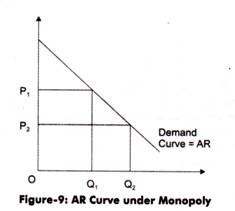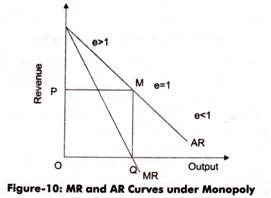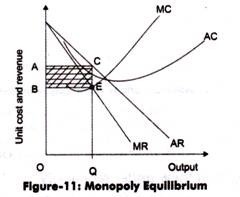Demand and Revenue under Monopoly:
In monopoly, there is only one producer of a product, who influences the price of the product by making Change m supply. The producer under monopoly is called monopolist. If the monopolist wants to sell more, he/she can reduce the price of a product. On the other hand, if he/she is willing to sell less, he/she can increase the price.
ADVERTISEMENTS:
As we know, there is no difference between organization and industry under monopoly. Accordingly, the demand curve of the organization constitutes the demand curve of the entire industry. The demand curve of the monopolist is Average Revenue (AR), which slopes downward.
Figure-9 shows the AR curve of the monopolist:
 In Figure-9, it can be seen that more quantity (OQ2) can only be sold at lower price (OP2). Under monopoly, the slope of AR curve is downward, which implies that if the high prices are set by the monopolist, the demand will fall. In addition, in monopoly, AR curve and Marginal Revenue (MR) curve are different from each other. However, both of them slope downward.
In Figure-9, it can be seen that more quantity (OQ2) can only be sold at lower price (OP2). Under monopoly, the slope of AR curve is downward, which implies that if the high prices are set by the monopolist, the demand will fall. In addition, in monopoly, AR curve and Marginal Revenue (MR) curve are different from each other. However, both of them slope downward.
ADVERTISEMENTS:
The negative AR and MR curve depicts the following facts:
i. When MR is greater than AR, the AR rises
ii. When MR is equal to AR, then AR remains constant
iii. When MR is lesser than AR, then AR falls
ADVERTISEMENTS:
Here, AR is the price of a product, As we know, AR falls under monopoly; thus, MR is less than AR.
Figure-10 shows AR and MR curves under monopoly:
 In figure-10, MR curve is shown below the AR curve because AR falls.
Table-1 shows the numerical calculation of AR and MR under monopoly:
In figure-10, MR curve is shown below the AR curve because AR falls.
Table-1 shows the numerical calculation of AR and MR under monopoly:

 As shown in Table-1, AR is equal to price. MR is less than AR and falls twice the rate than AR. For instance, when two units of
Output are sold, MR falls by Rs. 2, whereas AR falls by Re. 1.
As shown in Table-1, AR is equal to price. MR is less than AR and falls twice the rate than AR. For instance, when two units of
Output are sold, MR falls by Rs. 2, whereas AR falls by Re. 1.
Monopoly Equilibrium:
ADVERTISEMENTS:
Single organization constitutes the whole industry in monopoly. Thus, there is no need for separate analysis of equilibrium of organization and industry in case of monopoly. The main aim of monopolist is to earn maximum profit as of a producer in perfect competition.
Unlike perfect competition, the equilibrium, under monopoly, is attained at the point where profit is maximum that is where MR=MC. Therefore, the monopolist will go on producing additional units of output as long as MR is greater than MC, to earn maximum profit.
Let us learn monopoly equilibrium through Figure-11:

ADVERTISEMENTS:
In Figure-11, if output is increased beyond OQ, MR will be less than MC. Thus, if additional units are produced, the organization will incur loss. At equilibrium point, total profits earned are equal to shaded area ABEC. E is the equilibrium point at which MR=MC with quantity as OQ.
It should be noted that under monopoly, price forms the following relation with the MC:
Price = AR
MR= AR [(e-1)/e]
ADVERTISEMENTS:
e = Price elasticity of demand
As in equilibrium MR=MC
MC = AR [(e-1)/e]
Exhibit-2: